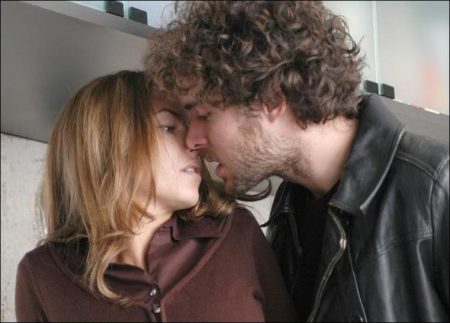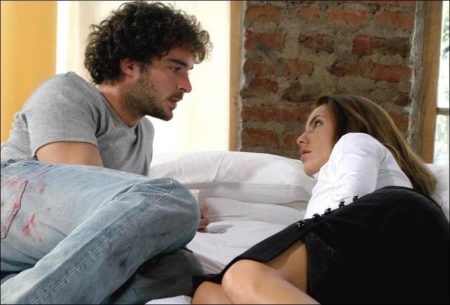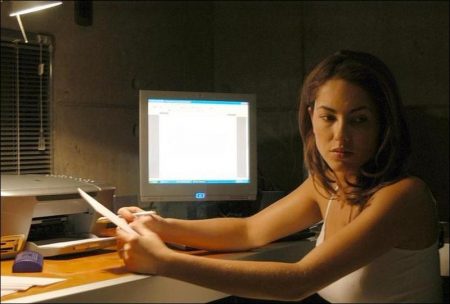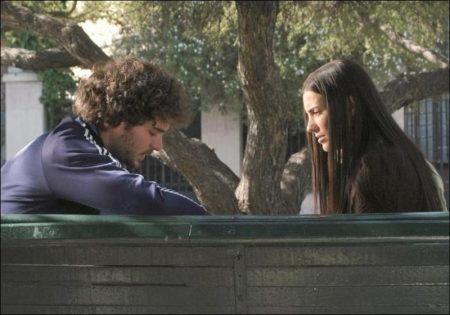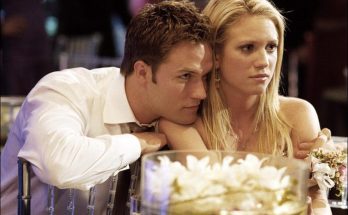My Brother’s Wife movie storyline. A woman bored with marriage discovers the pleasure and pain of infidelity in this stylish drama from Mexico. Zoe (Bárbara Mori) is a beautiful woman who has been married to Ignacio (Christian Meier) for nearly a decade. While Zoe still loves her husband, she feels the spark has gone out of their relationship, and she’s become restless and anxious.
Hoping to find the excitement she craves in forbidden fruit, Zoe falls into an affair with Gonzalo (Manolo Cardona), Ignacio’s rough-edged but handsome brother. Zoe and Gonzalo’s passionate affair is deeply satisfying to them both, but the adulterous couple must deal with the sharp sting of betrayal when Ignacio finds out they’ve been sleeping together. However the story takes a big turn when we find out the affair has only been a revenge towards his brother for Gonzalo. He is taking revenge for his brother raping him when he was younger therefore destroying his life.
About the Production
One of the most successful films in the history of Latin American cinema, La Mujer De Mi Hermano tells the sexy and dramatic story of Zoë and Ignacio, an unhappily married, yuppie couple living in Mexico City whose lives are upended by adultery and buried family secrets.
Featuring three of Latin America’s hottest young stars, including Mexican telenovela superstar Barbara Mori, the steamy character-driven film became a runaway box office smash across Latin America, out-performing big-budget Hollywood imports and breaking records in Mexico, Perú, Chile, Colombia and Venezuela.
“La Mujer De Mi Hermano is a very intimate movie,” says director Ricardo de Montreuil. “It’s a movie that talks about infidelity, sexuality, and the demons that people hide from the world.”
Originally a best-selling novel by Peruvian author Jamie Bayly, La Mujer De Mi Hermano is a psychologically acute exploration of a complicated love triangle involving two competitive brothers haunted by the past and the woman who comes between them.
While De Montreuil was eager to direct a film adaptation of the novel, Bayly was initially reluctant to allow his work to be translated for the screen, particularly after his disappointment over the film version of his first novel, No Se Lo Digas A Nadie (Don’t Tell Anyone). “Jamie really wanted to be sure that the film wouldn’t betray the novel,” says de Montreuil. “From the beginning I wanted to be as faithful as possible to his book and to the story that he wanted to tell.”
Once de Montreuil suggested that Bayly write the script and offer creative input on production issues like casting, Bayly agreed to proceed, developing the script for a year before he felt it was ready for production. “In large part, Jaime did the adaptation and then I collaborated with him on the final draft,” explains de Montreuil.
In an attempt to reach a broader Latin American audience, producer Stan Jakubowicz and de Montreuil decided to re-set the film in Mexico. “Generally, Latin American films are too local. They don’t translate well to other territories,” says Jakubowicz. “We tried to change that by making this a Mexican film.” The filmmakers’ logic is understandable: Mexico is Latin America’s largest film market and Mexican products are usually well received in other Latin American territories.
A Mexico-set film could also potentially appeal to the sizable Latino population in the United States, 80% of which are Mexican. Despite the story’s Mexican locale, the five-week production shot in Santiago, Chile and cast actors from across Latin America, achieving a broad mix of nationalities and cultures. Before filming began, the multi-national cast worked with dialect coaches to create an authentic, and uniform, Mexican accent.
De Montreuil readily admits that the massive popularity of La Mujer De Mi Hermano was due in part to the fortunate casting of Latin American superstar Barbara Mori in the role of Zoë, the adulterous wife. The Uruguay-born actress, now a Mexican citizen, had been a rising star in Mexican soaps for some years when de Montreuil invited her to audition for the role. But it wasn’t until after production was completed that Mori vaulted to stardom with “Rubi,” one of the most successful telenovelas in the history of Mexican television.
The show continues to break ratings records in Mexico and around the world and has pushed Mori firmly onto the global stage. Last year, People Magazine named her one of the 50 Most Beautiful Women in the World.
“Barbara is a supremely talented actress. We bet on her for her talent,” avows de Montreuil. “But the popular success she’s achieved as an actress helped La Mujer achieve the success that it did. We owe that to her and to the great talent of all who were involved in this production.”
Mori was immediately taken with Bayly’s intimate storytelling and the complex love triangle at the heart of the script. “It’s such an interesting movie,” she says. “Zoë is a young bourgeois girl who has spent practically all of her life in an unhappy marriage. She feels that she isn’t cared for, that her husband doesn’t appreciate her. But she’s also very submissive. She’s dying to experience passion in her life, but she doesn’t have the strength of character to leave her husband.”
Latin heart-throb Christian Meier uses his clean-cut good looks to perfect effect as Ignacio, Zoë’s “metro-sexual” husband who is experiencing his own mid-life crisis. “He’s a sad guy,” says Meier of his character. “He’s a guy who is on one hand very selfish, and on the other hand is a coward. He’s learned to love himself more than everyone else, including his wife. He likes to look good. He likes to be impeccable. But he can’t achieve it totally because he has something inside that is drowning him.”
Manolo Cardona, a Columbian actor whose sex appeal has made him one of Latin America’s biggest male stars, rounds out the love triangle as Gonzalo, Ignacio’s tempestuous artist brother. “Gonzalo breaks the harmony of Ignacio’s home for a reason that at the beginning of the film is unclear,” says the actor. “But as we go along we learn why he made this premeditated encounter with Zoë.”
Cardona believes that the film’s dramatic success lies in the unexpected revelations it makes of its three main characters. “Audiences can relate, because at first these characters appear normal. It’s not until later that we learn how wounded they are,” says the actor. “I think this story is completely universal. It could happen anywhere.”
“The movie culminates at the point where these three people are forced to relate to each other on a deeper level than they’re used to,” adds Meier. “Each character has to learn how to accept himself as a person and show others who he really is. That’s the basic drama of the movie.”
De Montreuil heightened the conflict between appearances and truth by giving the film a clean, glossy look that is a departure from the grittiness of recent Latin American imports. With the help of production designer Wolfgang Burman and director of photography Andres E. Sanchez, he used the finest locations in Santiago to create a world that appears almost artificially perfect. “One of the ideas of the story is to expose the hypocrisy of wealthy Latin American society,” says de Montreuil. “Latin films usually depict misery in the form of poverty, drugs and crime. This film reveals the misery underneath the surface of normalcy and privilege.”
Like Amores Perros and Y Tu Mama Tambien before it, La Mujer De Mi Hermano also introduces a cutting edge line-up of new Latin American music to American audiences. The film’s score was composed by Angelo Milli, and the soundtrack features some of the latest trend-setters in Latin alternative and electronica: Andrea Echeverri, electronic darlings Nortec Collective, Sara Valenzuela, Mexican Institute of Sound, The Pinker Tones and NYCbased up-and-comers Pacha.
Beto Cuevas, the Chilean-born vocalist from the multiple Grammy-winning Latin rock band, La Ley, also contributes a re-working of one of his band’s classic tracks, “Mentira.” Cuevas appears in a cameo in the film, in which he plays a Catholic priest. “It was a lot of fun, especially considering that people know me as a rock singer,” laughs Cueuvas. He adds, “I know Jaime Bayly and I love his books. And I really liked the screenplay. It was a completely new experience for me.”
Now that de Montreuil has followed his film’s phenomenal success across Latin America, he is eager to see how La Mujer De Mi Hermano’s depiction of hot-button taboos is received by American audiences. Yet whatever the outcome, the director rests confidently on the knowledge that he did justice to Bayly’s work. “When Jaime Bayly saw the movie for the first time,” recounts the director, “he sent me an email saying he loved the movie and appreciated it even more than the book. That was the best moment I could have asked for as a director.”
La Mujer de mi Hermano (2006)
La Mujer de mi Hermano
Directed by: Ricardo de Montreuil
Starring: Barbara Mori, Christian Meier, Manolo Cardona, Gaby Espino, Bruno Bichir, Angélica Aragón, Beto Cuevas, Cristina Alcaíno, Alexandre Yanez
Screenplay by: Jaime Bayly
Cinematography by: Andrés Sánchez
Film Editing by: Rosario Suárez
Art Direction by: Wolfgang Burmann
Music by: Angelo Milli
MPAA Rating: R for sexuality and language.
Distributed by: Lionsgate Films
Release Date: April 14, 2006
Views: 177
